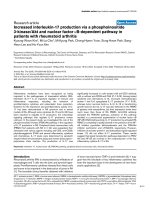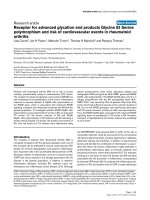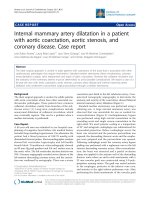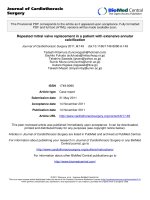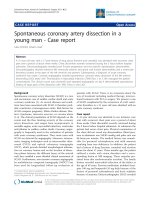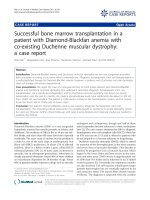Báo cáo y học: "First responder resuscitation teams in a rural Norwegian community: sustainability and self-reports of " docx
Bạn đang xem bản rút gọn của tài liệu. Xem và tải ngay bản đầy đủ của tài liệu tại đây (390.71 KB, 6 trang )
Rørtveit and Meland Scandinavian Journal of Trauma, Resuscitation and Emergency
Medicine 2010, 18:25
Open Access
ORIGINAL RESEARCH
© 2010 Rørtveit and Meland; licensee BioMed Central Ltd. This is an Open Access article distributed under the terms of the Creative
Commons Attribution License ( which permits unrestricted use, distribution, and repro-
duction in any medium, provided the original work is properly cited.
Original research
First responder resuscitation teams in a rural
Norwegian community: sustainability and
self-reports of meaningfulness, stress and
mastering
Sverre Rørtveit*
1
and Eivind Meland
2
Abstract
Background: Training of lay first responder personnel situated closer to the potential victims than medical
professionals is a strategy potentially capable of shortening the interval between collapse and start of
cardiopulmonary resuscitation (CPR) in cases of out-of-hospital cardiac arrest. In this study we trained lay first
responders personnel in basic life support (BLS) and defibrillation for cases of cardiac arrest and suspected acute
myocardial infarction (AMI).
Methods: Forty-two lay first responders living in remote areas or working in industries in the island community of
Austevoll, Western Norway, were trained in CPR and defibrillation. We placed particular emphasis on the first
responders being able to defibrillate a primary ventricular fibrillation (PVF) in patients with AMI. The trainees were
organised in four teams to attend victims of AMI and cardiac arrest while awaiting the arrival of the community
emergency medical services. The purpose of the study was to find out whether the teams were able to function during
the five-year study project, and to examine whether lives could be saved. The first responders completed
questionnaires each year on their experiences of participation. Data on the medical actions of the teams were also
collected.
Results: By the end of the project all groups were functioning. The questionnaires evidenced a reasonable degree of
motivation and self-evaluated competence in both types of group organisation, but in spite of this attrition effects in
the first responders were considerable. The first responders were called out on 24 occasions, for a total of 17 patients.
During the study period no case of PVF occurred after the arrival of the first responders, and the number of AMIs was
very low, strongly deviating from what was anticipated. No lives were saved by the project.
Conclusions: The teams were sustained for almost five years without any significant deterioration of self-reported
stress or mastering, but still showed attrition effects. Evaluated as a medical project the intervention was not successful,
but the small scale prevents us from drawing firm conclusions on this aspect.
Introduction
The odds of surviving a cardiac arrest remain low, and
have not improved in the last 20 years, despite the devel-
opment of new methods in Advanced Life Support (ALS)
[1]. The time interval from collapse in cardiac arrest to
the start of cardiopulmonary resuscitation (CPR) remains
the main determinant of the chance of survival. Training
of lay first responder personnel situated closer than med-
ical professionals to the potential victims is a strategy
potentially capable of shortening this interval. World-
wide, this has been attempted either by introducing pub-
lic access defibrillation (PAD) schemes, or by training fire
department or police personnel as first responders.
In remote rural settings where PAD schemes are not a
practicable option and there are no local full-time fire or
police personnel, a strategy of getting first responders to a
patient at risk of ventricular fibrillation might be poten-
* Correspondence:
1
Municipal Health Services of Austevoll commune, 5399 Bekkjarvik, Norway
Full list of author information is available at the end of the article
Rørtveit and Meland Scandinavian Journal of Trauma, Resuscitation and
Emergency Medicine 2010, 18:25
Page 2 of 6
tially fruitful. A substantial proportion of victims dying
from acute myocardial infarction (AMI) die from primary
ventricular fibrillation (PVF) shortly after the start of
symptoms [2]. If personnel equipped with an automated
external defibrillator (AED) and competent in defibrilla-
tion and Basic Life Support (BLS) are present at the scene
when the patient begins to fibrillate, defibrillation can
take place immediately, and the chances of survival are
substantially higher [3]. In this study first responder per-
sonnel were trained not only in BLS and defibrillation for
cases of cardiac arrest, but also and principally for cases
where the doctor suspected patients of having AMI.
Our aim was to investigate whether organising first
responder personnel in teams was feasible and sustain-
able over a long time period. Our goal was also to exam-
ine the extent to which members of such teams report
mental stress, their experience of mastering and to what
extent participants felt their tasks to be meaningful.
Finally, we wished to investigate whether lives could be
saved by the project.
Materials and methods
The municipality of Austevoll in Western Norway con-
sists of several inhabited islands with a total population of
4400. There is no bridge connection to the mainland. The
islands of Hundvåkøy and Storakalsøy have 700 inhabit-
ants. The two islands are connected by a bridge, but at the
time of the study period they were not connected by
bridge to the main islands of the community. Doctor and
ambulance emergency calls to these islands were by
ambulance boat and taxi. In 2002 local initiators cooper-
ated with a local supplier of medical equipment, who was
also a BLS and defibrillation instructor, and with the
municipality medical officer (project leader, SR) to set up
first responder teams. The same was also done at two
centres of industry in the community, with a total of 150
employees.
For each of the two islands one AED was deployed
(neighbourhood teams), along with one AED for each of
the industrial areas (workplace teams). In the four teams
a total of 42 persons were given a course in BLS com-
bined with defibrillation training, developed by the Nor-
wegian Resuscitation Council. Participation in the first
responder teams was on a volunteer basis without remu-
neration. Of the 42 participants, 39 consented to give per-
sonal information: 14 female and 4 male participators in
the neighbourhood teams, and 8 and 13 in the workplace
teams. In the neighbourhood teams 5 were aged 20-39
and 13 were aged 40-59; the corresponding figures for the
workplace teams were 12 and 9.
The project leader took part in the organising, training
and surveillance of the teams, and issued the delegations
to operate the defibrillator.
The AEDs were placed at dedicated locations on each of
the two islands. In an emergency call with suspected AMI
or cardiac arrest, the doctor on duty in the municipality
would decide whether to alert the first responder team.
The first responders did not participate by duty roster,
but were called according to a telephone list, with the
main emphasis on mobile phones. Two or three first
responders were sent to the patient, bringing the AED,
with as short a dispatch interval as possible.
The first responders were taught to attach the defibrillat-
ing electrodes to the patient's chest, but not to turn the
AED on, except in the case of cardiac arrest. The doctor
and ambulance personnel would take over the manage-
ment of the patient on arrival. At the industrial centres,
company internal warning systems alerted the first
responders.
After the end of every action, the project leader com-
pleted a registration form following a telephone conver-
sation with the team members. Recorded events were
time point and time intervals of falling ill, telephone calls,
response time for the first responders and medical per-
sonnel, emergency medical measures taken, and medical
end points. Time points and time intervals were esti-
mated by the project leader from the information given
by the first responders, often as a mean of the evaluation
of the team members, and the recorded intervals of the
ambulance personnel were often included in the esti-
mates.
During the study period the neighbourhood groups had
considerably more follow-up than the workplace groups.
Both types of groups underwent retraining and redelega-
tion once a year. In addition, the neighbourhood groups
had a total of eight follow-up meetings originating in a
need for evaluation of recent actions, discussions of pro-
cedures, and preparing and performing larger-scale train-
ing.
Before the start of the project, the members of the first
responder teams were asked to give information on their
background and their expectations of participation in the
project (14 questions). In addition, they were asked to
consent to give information on similar topics during the
course of the study. Members who gave such consent
were sent a questionnaire comprising 15 questions during
the study period, and were asked to select the most
appropriate answer preformulated on the form. The first
questionnaire was sent out six months after the start of
the study, and thereafter annually. Participants selected
responses on a scale with four levels ranging from 'very
good' to 'poor'. A few of the questions had other specific
response alternatives according to the nature of the ques-
tion, all of them graded in four levels.
We estimated the expected AMI and cardiac arrest
events from the Norwegian mean incidence of AMI
(1997-2001) and a national expert estimate of cardiac
Rørtveit and Meland Scandinavian Journal of Trauma, Resuscitation and
Emergency Medicine 2010, 18:25
Page 3 of 6
arrest [4,5]. From the estimation eleven cases of AMI and
four cases of cardiac arrest were anticipated during the
planned study period of five years. The results of this
paper are from the period May 2002 to May 2007.
Ethics
The study was approved by the Regional Committee for
Medical and Health Research Ethics (REK) and the Nor-
wegian Data Inspectorate.
Results
Participants
At the start of the project, the first responder teams com-
prised 42 members. Twenty-three were organised by the
workplace groups and 19 belonged to the neighbourhood
groups. At the end of the project, 27 members were still
participating, 17 in the workplace groups and 10 in the
neighbourhood groups. Table 1 shows the variation in the
number of participants over the study period. At the end
of the project, one of the two neighbourhood groups had
lost five of its original eight members, and its functioning
was maintained only by the recruitment of one additional
first responder during the study period. Four of the mem-
ber withdrawals occurred in the last months of the proj-
ect, between the time of the participants' returning of the
last questionnaire and the end of the project.
Qestionnaire responses
Thirty-nine of the original participants had consented to
complete the questionnaires. Thirty-nine questionnaires
were completed and returned at the start of the study; at
six months 37 were completed; at two and a half years 31
were completed, and at four and a half years 26 question-
naires were completed. In table 2 we give results from the
completed questionnaires by 1/2, 2 1/2 and 4 1/2 years.
Throughout the study period the first responders of the
neighbourhood groups evaluated their CPR and defibril-
lation competence, as well as the performance of the
group they belonged to, as slightly higher than the work-
place groups, but none of these differences are statistical
significant. The mean difference between the groups and
within each group over time concerning the the other
self-reported variables was small and of no clinical rele-
vance. Being in actions was not self-evaluated as obvi-
ously changing the first responders' enthusiasm of
participation in the project.
Patients
The neighbourhood groups were called out on 24 occa-
sions, for a total of 17 patients. On one occasion the
group should have been alerted according to procedure,
but failure of communication prevented this, and this
case is not included in the material. The patients were
aged 36-92 years, with a mean of 66 years. Since more
than one first responder took part in each action, a total
of 63 person-actions are recorded for the neighbourhood
members. Seven first responders participated in cardio-
pulmonary resuscitation, one of them by giving defibrilla-
tion. The mean participation per neighbourhood team
member per year was 0.74 actions.
The reason for call out was cardiac arrest in 6 of the 24
actions, and suspected AMI in 18 cases. For the arrest
patients, the indication "no shock indication" was given
by the first responder's turning on the automated defibril-
lator in five of the six cases. This means the initial rhythm
was asystole, as this was the way the machines were pro-
grammed from the manufacturer. To the sixth patient the
machine was not turned on, since there was a verified too
long interval without circulation or CPR. All the six car-
diac arrest patients were declared dead on scene by the
doctor. In two instances, by chance the first personnel to
reach the patient was a paramedic or doctor.
The time intervals from alarm call to arrival of first
responder and of AED, is given for suspected AMI and
for cardiac arrest in table 3. The first responder arrived at
the patient in a median of 22.5 minutes before the ambu-
lance personnel and doctor; the AED was there in a
median of 20 minutes before the ambulance and doctor
arrived.
In the 18 cases of suspected AMI, acute chest pain was
the first symptom in 13 cases and other AMI-related
symptoms in five cases. Upon doctor's examination on
site, the condition was deemed not to necessitate hospi-
talisation in four cases. Of the remaining cases, one
Table 1: Participants by group and time in the project. Response rate at relevant times.
0.5 years 1.5 years 2.5 years 3.5 years 4.5 years 5 years
MF T A
N (%)
TA
N (%)
TA
N (%)
TA
N (%)
TA
N (%)
MF T
Workplace 16 7 23 19 (83) 21 17(81) 23 17(74) 19 15 (79) 19 13(68) 13 6 19
Neighb. 4 15 19 18 (95) 18 16(89) 16 14(88) 16 14 (88) 15 13 (87) 2 9 11
Total 20 22 42 37 (88) 39 33(85) 39 31(79) 35 29 (83) 34 26 (76) 15 15 30
M = male, F = female, T = total, A = Answers
Rørtveit and Meland Scandinavian Journal of Trauma, Resuscitation and
Emergency Medicine 2010, 18:25
Page 4 of 6
patient was confirmed in hospital as having an AMI,
twelve were evaluated not to have AMI, and for one
patient hospital data was not obtained. None of the
patients with suspected AMI as the reason for the emer-
gency call out had a cardiac arrest while attended only by
the first responders.
First responders' actions
In 62% of alerts the first team member called was able to
attend the patient, and in 70% the second team member
called was able to respond. In one instance the ambulance
personnel were not able to contact any of the first
responders. The workplace groups were never called into
action during the study period. Individual members of
the workplace groups did take part in emergencies,
attending an AMI-suspected patient or performing CPR
on four occasions, though all of these instances were out-
side the workplace.
The training procedure of attaching the defibrillator elec-
trodes to the patient's chest upon the first responder's
arrival at the patient was followed in five instances and
not followed in 12 instances. Reported reasons for not
attaching the electrodes were evaluation of the situation
by the first responders as non-urgent (2 instances), not
wanting to risk the integrity of the patient (1), instruc-
tions by the paramedic or doctor not to attach the elec-
trodes (1), and when the ambulance and doctor would
arrive very shortly after the first responder (2). In five
instances no reason was given for deviating from the pro-
Table 2: First responders' selfreporting after 1/2, 2 1/2 and 4 1/2 years. Mean values. Values 1 (minimal) - 4 (maximal). Wg =
workplace groups, Ng = Neighbourhood groups.
1/2 year 2 1/2 years 4 1/2 years
Wg (N = 19) Ng
(N = 18)
Wg (N = 17) Ng (N = 14) Wg (N = 13) Ng (N = 12)
Physical
health
3.3 3.7 3.2 3.0 3.5 3.3
Mental health 3.6 3.7 3.5 3.7 3.8 3.7
General
anxiety
3.7 3.8 3.5 3.8 3.5 3.7
Health anxiety 3.6 3.7 3.6 3.4 3.5 3.6
Meaningfulne
ss of task
3.6 3.4 3.5 3.6 3.2 3.4
Personal stress 1.5 1.6 1.3 1.7 1.3 1.8
Familiar stress 1.1 1.3 1.0 1.3 1.0 1.3
Sense of
group
performance
2.8 3.2 2.8 3.3 2.8 3.2
Training in
between
sessions
2.2 2.3 2.2 2.0 1.9 2.1
Selfrated
mastering of
CPR and
defibrillation
2.9 3.1 2.9 3.4 2.8 3.2
Participated in
action
1
N = 1 N = 6 N = 0 N = 6 N = 1 N = 5
Selfrated
performance
of action
3 3.7 - 2.3 3 3.8
Change of
enthusiasm
after action
2
2.0 2.2 - 2.7 2.0 2.0
1
Number of first responders who had participated in action since last return of questionnaire
2
Values of variable: 1 = less enthusiastic 2 = unchanged 3 = more enthusiastic 4 = much more enthusiastic
Rørtveit and Meland Scandinavian Journal of Trauma, Resuscitation and
Emergency Medicine 2010, 18:25
Page 5 of 6
cedure, and in one instance it is not known whether the
electrodes were attached or not.
Discussion
Deployment of automated external defibrillators and
training of first responders is carried out worldwide rang-
ing in scale from very large projects like the US Public
Access Defibrillation Trial [6] to very small schemes with
participation of only a few people.
Our study gives data on the formation and follow-up of
first responders organised in four groups of just under
ten persons per group. We give data on the opinions,
experiences, medical activity and participation of each
member of the groups, collected annually for a time span
of five years. This study thus documents the feasibility
and sustainability of first responder groups. We maintain
that such documentation should be mandatory in these
types of projects. To our knowledge, this kind of informa-
tion has not been published by others.
All four groups were functioning at the end of the five-
year period. Over the study period the participants gen-
erally reported a reasonable, though not high level of self-
evaluated competence in CPR and defibrillation, a high
degree of meaningfulness of the participation, and low
self-rated stress. In spite of a high difference in follow-up
and experience of actions between the two types of group
organisation, their subjectively evaluated meaningfulness
and competence of CPR and defibrillation was surpris-
ingly similar.
Four of the member withdrawals occurred in the last
months of the project. It is possible that this was due to a
reduction in perceived meaningfulness or increased
sense of stress not captured by the last round of question-
naires, which were performed a half year before the end
of the project. Some of the members of the neighbour-
hood group with the highest withdrawal said they felt the
task was burdensome, since responsibility was shared
among only a few people. We evaluate the high with-
drawal in the end period of the project as a real effect of
wear and tear, and it was seen in the groups exposed to
real actions.
The dispatch procedure resulted in overlong response
times, and adherence to the training procedure was sub-
optimal. The findings of this study imply that medical
professionals organising first responder schemes should
consider thoroughly which practical circumstances ought
to be present for a project to be successful. The possibility
that the first responders will stay the course should be
discussed with participants from the beginning. At the
yearly retraining and delegation, we recommend holding
an informal discussion with the first responder group,
with emphasis on how the group members feel about
their participation. If a first responder project is no longer
functioning in practice, it should be formally terminated.
This study was in part stimulated by the idea of getting
defibrillation-competent personnel rapidly to patients
with suspected AMI, in order to defibrillate them in case
of PVF [3]. During the study period no case of PVF
occurred after the arrival of the first responders, and in
Table 3: Response times (interval of minutes)
Suspected AMI Cardiac arrest
Call-first responder1 Call-AED2
Call-first responder Call-AED
0-2 min 2 - - -
3-5 min 21
9-10 min 4 4 - -
11-15 min 5 4 4 2
16-20 min 3 2 - 1
21-25 min - 2 - 1
26-40 min 3 4 - -
41-6011- -
AED not brought 1
Unknown - 1 - -
Total 18 18 6 6
1
Interval from alarm call to arrival of the first responder at the patient
2
Interval from alarm call to arrival of automated defibrillator
Rørtveit and Meland Scandinavian Journal of Trauma, Resuscitation and
Emergency Medicine 2010, 18:25
Page 6 of 6
fact the number of AMIs was extremely low, strongly
deviating from what was anticipated. This type of dis-
crepancy is possible in a small study population such as
ours. Shifting AMI epidemiology, with fewer ST-eleva-
tion AMIs and an older AMI population, may also have
contributed to the results [7].
The Norwegian Air Ambulance 'Early Heartstart' scheme
deployed AEDs and have reported some of their data[8].
It was initiated in 2002 and summarised in annual
reports, the most recent for 2005. In their project, 228
AEDs were deployed by the end of 2005 to 181 Norwe-
gian municipalities, primarily to fire departments. In
2005 the AEDs were operated in 44 medical emergencies,
and in 42% of these defibrillation was performed. Two of
the defibrillated patients survived. Diagnoses for the
actions and a list of the medical procedures undertaken
are not given, and the methods of data collection are not
described. Planned procedures for the first responders'
medical actions and their cooperation with the munici-
pality doctors and paramedics are similarly not included.
It is well known that other organisations and companies
cooperate with suppliers of AEDs in training CPR and
defibrillation and deploying AEDs at workplaces and
public locations. We have not been able to obtain data
from any of these. A main problem concerning the wide-
spread organisation of first responder groups is that the
extent and reliability of the data reporting are highly vari-
able, and for most probably non-existent. This means that
we do not know in the majority of cases whether defibril-
lation first responder projects save lives.
In conclusion, we judge the validity of the study to be sat-
isfactory, as we carefully observed and registered data
during the study period according to a preplanned proce-
dure. All groups functioned throughout the five-year
study period. No life-saving effect was detected during
this project, but this should be seen in the context that
the main weakness of the study is the low population of
potential patients and therefore low power to determine
any real life-saving effects.
Competing interests
The authors declare that they have no competing interests.
Authors' contributions
SR initiated the study and collected the data, worked out the first draft of the
manuscript, took part in the design of the study and the statistical analyses. EM
took part in the design of the study and the statistical analyses, and has revised
the manuscript. Both authors read and approved the final manuscript.
Acknowledgements
We wish to thank the first responders, the doctors and ambulance personnel of
Austevoll for their participation in the study.
Funding: SR was part-time granted for three months by The Norwegian Com-
mittee on Research in General Practice, for the planning of the study.
Author Details
1
Municipal Health Services of Austevoll commune, 5399 Bekkjarvik, Norway
and
2
Department of Public Health and Prim Health Care, Section for General
Practice, Kalfarveien 31, 5018 Bergen, Norway
References
1. Kramer-Johansen J: Has survival after out-of-hospital cardiac arrest
improved during the last 50 years? Scand J Trauma Resusc Emerg Med
2007, 15:135-9.
2. Gheeraert PJ, De Buyzere ML, Taeymans YM, Gillebert TC, Henriques JP, De
Backer G, De Bacquer D: Risk factors for primary ventricular fibrillation
during acute myocardial infarction: a systematic review and meta-
analysis. Eur Heart J 2006, 27:2499-2510.
3. Norris RM, on behalf of the United Kingdom Heart attack study
collaborative group: Fatality outside hospital from acute coronary
events in three British health districts 1994-95. BMJ 1998, 316:1065-70.
4. Hovland A, Bjørnstad H, Strømsnes O, Waage-Nielsen E, Sexton J: Akutt
hjerteinfarkt i Bodø gjennom 15 år. Tidsskr Nor Laegeforen 2007,
127:1631-3.
5. Steen P, Juvkam P: Kan overlevelse ved uventet prehospital hjertestans
i Norge bedres? Tidsskr Nor Legeforen 1998, 118:764-5.
6. Hallstrom AP, Ornato JP, Weisfeldt M, Travers A, Christenson J, McBurnie
MA, Zalenski R, Becker LB, Schron EB, Proschan M, Public Access
Defibrillation Trial Investigators: Public-access defibrillation and survival
after out-of-hospital cardiac arrest. N Engl J Med 2004, 351(7):637-46.
7. Lorgis L, Zeller M, Beer JC, Lagrost AC, Buffet P, L'Huillier I, Sicard P, Cottin Y:
Épidemiologie du syndrome coronaire aigu en Europe. Ann Cardiol
Angeiol (Paris) 2007, 56(Suppl 1):S2-7.
8. Zakariassen E: Rapport 2005. Tidlig hjertestart. 2007 [http://
www.norskluftambulanse.no/AarsrapportTHS2005_DjM2r.pdf.file].
doi: 10.1186/1757-7241-18-25
Cite this article as: Rørtveit and Meland, First responder resuscitation teams
in a rural Norwegian community: sustainability and self-reports of meaning-
fulness, stress and mastering Scandinavian Journal of Trauma, Resuscitation
and Emergency Medicine 2010, 18:25
Received: 30 December 2009 Accepted: 4 May 2010
Published: 4 May 2010
This article is available from: 2010 Rørtveit and Meland; licensee BioMed Central Ltd. This is an Open Access article distributed under the terms of the Creative Commons Attribution License ( which permits unrestricted use, distribution, and reproduction in any medium, provided the original work is properly cited.Scandinavi an Journal of Trau ma, Resuscita tion and Emergenc y Medicine 2010, 18:25

